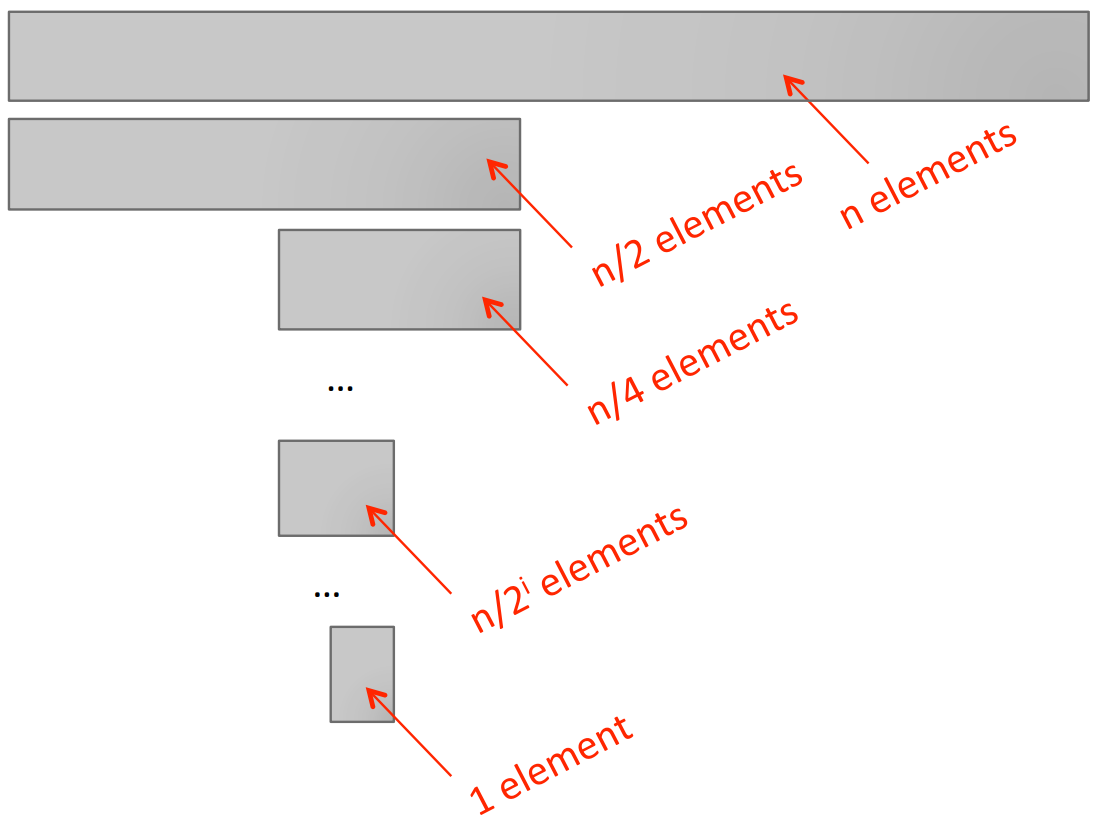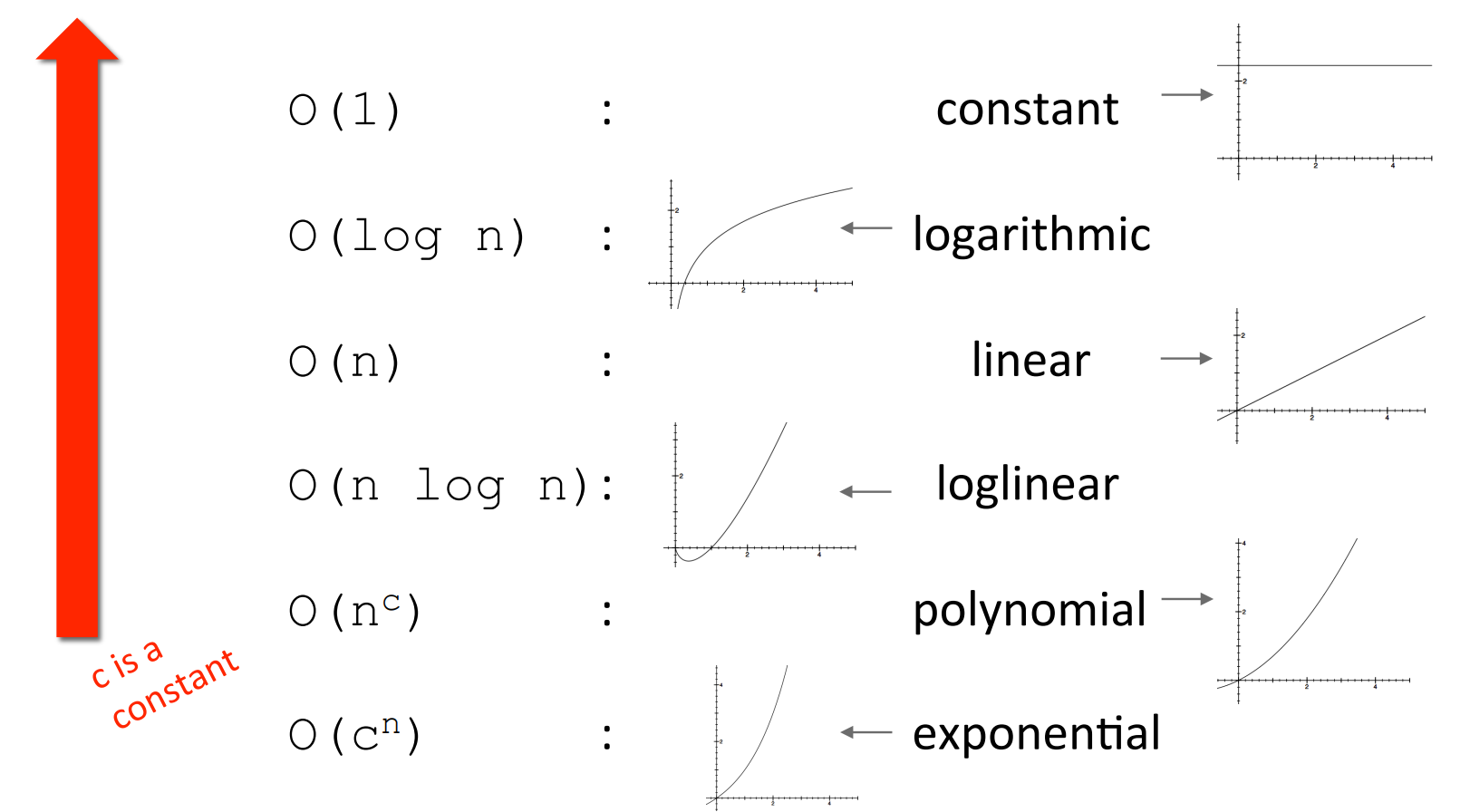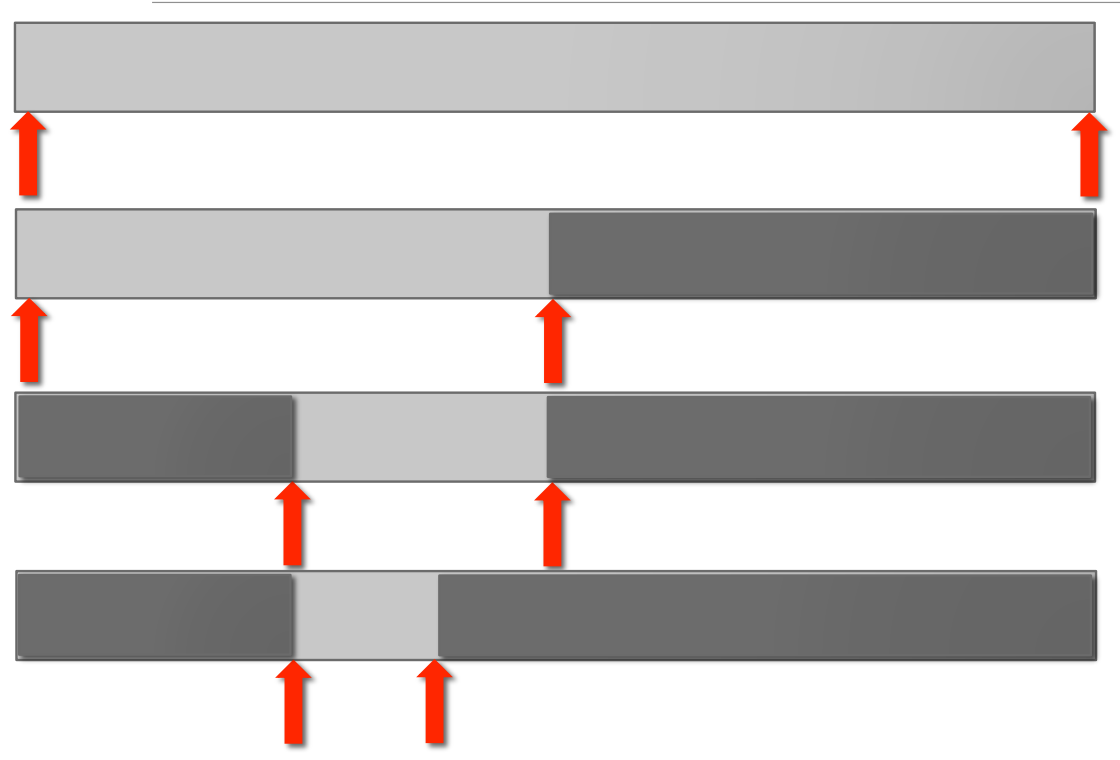
Goals:
Complexity classes in increasing order:

| Class | n=10 | n=100 | n=1000 | n=1000000 |
| O(1) | 1 | 1 | 1 | 1 |
| O(log n) | 1 | 2 | 3 | 6 |
| O(n) | 10 | 100 | 1000 | 1000000 |
| O(n log(n)) | 10 | 200 | 3000 | 6000000 |
| O(n^2) | 100 | 10000 | 1000000 | 1000000000000 |
| O(2^n) | 1024 | 1.2*10^31 | 1.07*10^311 | forget it! |
Constant complexity class
Logarithmic complexity class
Searching in a list
def search(L, e):
for i in range(len(L)):
if L[i] == e:
return True
if L[i] > e:
return False
return False
This method is called a sequential search.
Self-similarity: find BigO of smaller code blocks and combine them The BigO pseudocode does not cover function calls and some other cases (to keep the discussion simple) --- though experiment to expand this
findBigO(codeSnippet):
if codeSnippet is a single statement:
return O(1)
if codeSnippet is a loop:
return number_of_times_loop_runs * findBigO(loop_inside)
for codeBlock in codeSnippet:
return the_sum_of findBigO(codeBlock)
for i in range(N * N):
for j in range(3, 219):
print("sum: ", i + j)
print("Enjoy COL100");
Show the working of findBigO on this code snippet.
Binary search
e in list LL[i] == eL[i] is larger or smaller than eL for e.Binary search complexity analysis

log n.O(log n) where n is len(L).Binary search implementation 1
def binsearch1(L, e):
if L == []: # this check and return is constant-time-complexity, or O(1)
return False
elif len(L) == 1: # this check is also O(1)
return L[0] == e # this check is also O(1)
else:
half = len(L)//2 # constant O(1)
if L[half] > e: # Is L[half] O(1)? Let's assume for now it is.
return binsearch1(L[:half], e) # involves copying the list, not constant
else:
return binsearch1(L[half:], e) # involves copying the list, not constant
Complexity of binsearch1:
O(log n) calls to binsearch1
n, in worst case in case of range of size 1 when n/2k=1, or k=log nO(n) for each binsearch1 call to copy list:
O(log n)*O(n) indicates that the complexity can be as high as O(n log n).O(n/2i). Thus, the total cost of copying is n + n/2 + n/22 + ... + 1, which is equal to 2n.A better implementation of binary search
n=len(L).
def binsearch_helper(L, e, low, high):
if high == low:
return L[low] == e
mid = (low + high)//2
if L[mid] == e:
return True
elif L[mid] > e:
if low == mid: #nothing left to search
return False
else:
return binsearch_helper(L, e, low, mid - 1) #constant to set up the call. The actual call takes longer
else:
return binsearch_helper(L, e, mid + 1, high) #constant to set up the call. The actual call takes longer
def binsearch(L, e):
if len(L) == 0:
return False
else:
return binsearch_helper(L, e, 0, len(L) - 1) #constant to set up the call. The actual call takes longer
Complexity of binsearch:
O(log n) calls to binsearch_helper
n, in worst case in case of range of size 1 when n/2k=1, or k=log nO(1) for each binsearch_helper execution (including the cost to set up the call)O(log n)*O(1) indicates that the complexity is O(log n).Another example of logarithmic complexity: int2str
def int2str(n):
digits = '0123456789'
if n == 0:
return '0'
result = ''
i = n
while i > 0:
result = digits[i%10] + result
i = i//10
# can you place an assertion here?
return result
What is the correctness argument? What assertion can you put at the end of the body of the while loop? Ans: assert(10**(len(result))*i+int(result)==n). This is an invariant.
Analyzing the complexity of the program above:
n by 10 such that it remains greater than 0?O(log(n))O(1)O(len(result)) as it involves a copy, which is O(log n) in the worst case and average case.O(log n).O(log2 n).How can you change the implementation so it takes O(log n) time?
result be a list, initialized to [] and appended-to using the append() function (which is O(1))O(len(result))) and join it to form a string (again O(len(result))).Linear complexity
Analyzing the complexity of an iterative implementation of the factorial function
def fact_iter(n):
prod = 1
for i in range(1, n+1):
prod *= i
return prod
O(n). n times around loop, constant time each time.Analyzing the complexity of a recursive implementation of the factorial function
def fact_rec(n):
""" assume n >= 0 """
if n <= 0:
return 1
else:
return n*fact_rec(n-1)
O(n) because the number of function calls is linear in n, and constant effort to set up call.Log-linear O(n log n) complexity
Polynomial complexity
isSubset function:
def isSubset(L1, L2):
for e1 in L1:
matched = False
for e2 in L2:
if e1 == e2:
matched = True
break
if not matched:
return False
return True
Exponential complexity
Complexity of Towers of Hanoi
tn denote time to solve tower of size n.tn = 2tn-1 + 1 = 2(2tn-2 + 1) + 1 = 4tn-2+ 2 + 14tn-2+ 2 + 1 = 4(2tn-3+1)+2 + 1 = 8tn-3 + 4 + 2 + 1k expansions: 2ktn-k+2k-1 + 2k-2 + ... + 4 + 2 + 1n-k=1: 2n-1 + 2n-2 + 2n-3 + ... + 4 + 2 + 12n-1.2n.Exponential complexity example: Power set
{1, 2, 3, 4} would generate (order does not matter):
{}, {1}, {2}, {1,3}, {1,4}, {2,3}, {2,4}, {3,4}, {3}, {4}, {1,2}, {1,2,3}, {1,2,4}, {1,3,4}, {2,3,4}, {1,2,3,4}
Power set --- concept
n); and all of those subsets with n
added to each of them belong to the bigger power set.Exponential complexity
def genSubsets(L):
res = []
if len(L) == 0:
return [[]] # list of empty list
smaller = genSubsets(L[:-1]) #all elements without last element
extra = L[-1:]
new = []
for small in smaller:
new.append(small+extra) # for all smaller solutions, add one with last element
return smaller+new # combine those with last element and those without
Assumptions:
append() is constant timesmall+extra can be O(n) time.k, the solution is of size 2k.tn denote time to solve problem of size n.sn denote size of solution to a problem of size n.tn=tn-1+c3*n*sn-1+c1*sn-1+c2 (where c1,c2,c3 are some constants)tn>=tn-1+c1*2n-1+c2>=tn-2+c1*2n-2+c1*2n-1+2*c2>=tn-k+c1*2n-k+c1*2n-k-1+...+2n-1+k*c2>=t0+c1*20+c1*21+...+c1*2n-1+n*c2>=1+c1*2n+n*c2>O(2n)Summary of examples of complexity classes
O(1): code does not depend on size of the inputO(log n): reduce problem in half with constant effort at each stepO(n): simple iterative or recursive programs with a single loop or linear recursionO(nlog n): will see next timeO(nc): nested loops or recursive callsO(cn): multiple recursive calls at each level, where the number of levels is linear in nExample: Iterative Fibonacci
def fib_iter(n):
if n == 0: # O(1)
return 0 # O(1)
elif n == 1: # O(1)
return 1 # O(1)
else: # O(1)
fib_i = 0 # O(1)
fib_ii = 1 # O(1)
for i in range(n-1): # the loop executes O(n) iterations
tmp = fib_i # O(1)
fib_i = fib_ii # O(1)
fib_ii = tmp + fib_ii # O(1)
return fib_ii # O(1)
Analysis:
O(1)c1*O(1) + O(n)*c2*O(1) = O(n)
Example: Recursive Fibonacci
def fib_rec(n):
""" assumes n an int >= 0 """
if n == 0: # O(1)
return 0 # O(1)
elif n == 1: # O(1)
return 1 # O(1)
else: # O(1)
return fib_rec(n-1) + fib_rec(n-2)
Draw tree. Show the growth for small values of n. Claim (without proof) that the complexity is exponential, slightly lower than 2n.
Big-O summary
Lists: n is len(L)
Dictionaries: n is len(d)